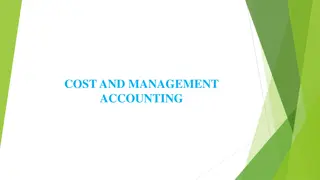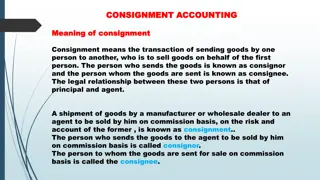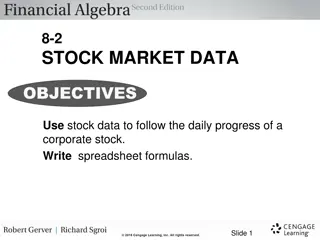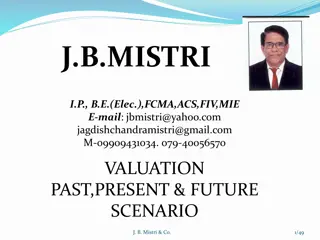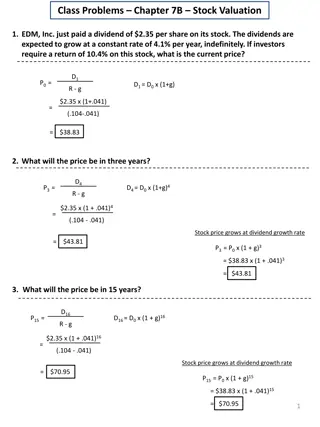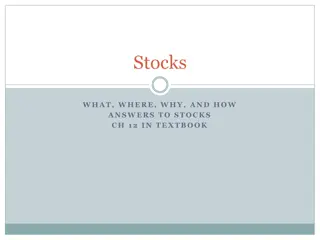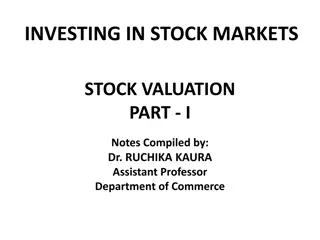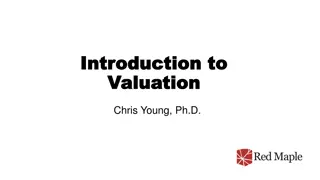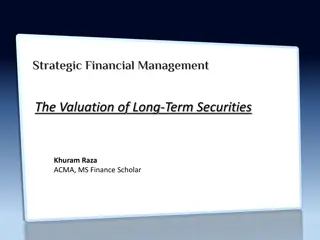Valuation and Accounting for Unsold Stock in Consignment Transactions
Valuation and accounting for unsold stock in consignment transactions is crucial for determining true profit or loss. The cost of consigned goods plus proportionate expenses must be considered. Recurring and non-recurring expenses play a significant role in valuing closing stock. The value of unsold stock impacts the profit or loss on consignment, and proper recording in the books of the consignor is vital. Loss of goods during transit can be normal or abnormal, and the treatment in accounting varies accordingly.
Download Presentation

Please find below an Image/Link to download the presentation.
The content on the website is provided AS IS for your information and personal use only. It may not be sold, licensed, or shared on other websites without obtaining consent from the author.If you encounter any issues during the download, it is possible that the publisher has removed the file from their server.
You are allowed to download the files provided on this website for personal or commercial use, subject to the condition that they are used lawfully. All files are the property of their respective owners.
The content on the website is provided AS IS for your information and personal use only. It may not be sold, licensed, or shared on other websites without obtaining consent from the author.
E N D
Presentation Transcript
WELCOME CLASS: B.COM PART-1 SUBJECT: FINANCIAL ACCOUNTING TOPIC: CONSIGNMENT ACCOUNTING TRANSACTIONS VALUATION OF STOCK ON CONSIGNMENT AND ACCOUNTING FOR LOSS OF GOODS Prepared By Dr. SHAHID IQBAL Guest Faculty Marwari College, Darbhanga, Mobile no. and Whatsup no. : 7004160257 Email ID: shahidlnmu@gmail.Com 1
Till now we have presumed that all the goods consigned are sold. But in practice we find that at the time of submitting the accountsale , a part of goods consigned may still be unsold and may be lying with the consignee. In order to calculate the true profit or loss on consignment, the unsold stock should be valued and accounted for. VALUATION OF STOCK ON CONSIGNMENT Valuations of unsold stock is usually done at cost. Cost, in case of consignment stock, would include the cost at which the goods are consigned plus, the proportionate non-recurring expenses. All the non-recurring expenses, whether incurred by the consignor or by the consignees, are to be taken into account. In the absence of details of expenditure incurred by the consignee, all expenses incurred by him are to be taken as recurring expenses and thus are not to be considered in the calculation of closing stock. In other words, while valuing the closing stock we add such proportionate expenses to 2
the cost price that have been incurred upto the time the goods are brought to the place of the consignee. Any other expenses paid by the consignor or the consignee after this point will not be considered as these expenses do not add to the value of the goods. Such expenses are godown rent, selling expenses, carriage outwards, godown insurance, discount etc. Usually following expenses are added for calculation of closing stock : Carriage and Freight, Loading Charges, Custom Duty, Clearing Charges, Dock Dues, Carriage paid upto the Godown, and Unloading charges. Following are the expenses which are not considered for calculation of closing stock : Godown rent, Discount, Bad Debts, Insurance of the goods in the Godown, and Selling and Distribution expenses. One can notice that all expenses incurred by the consignor are considered for valuation of the closing stock. The problem arises only selecting recurring expenses in case of consignee. 3
The value of unsold stock affects the profit or loss on any consignment so its valuation and recording in the books of consignor is very important. It is shown on the credit side of Consignment Account for which the journal entry passed would be as : Stock on Consignment To Consignment A/c (Being the values of sold stock) A/c Dr. On the other hand the Consignee, will not pass any entry for the closing stock. It is because he is not the owner of the goods and does not pass any entry even when the goods are received or he returns the goods. 4
ACCOUNTING FOR LOSS OF GOODS Goods sent on consignment may be lost or damaged in transit. The loss of goods may be either (i) normal or (ii) abnormal Treatment in the books of accounts will depend upon the nature of loss. Normal Loss : Loss of goods is sold to be normal when it is natural, unavoidable and is due to inherent characteristic of the goods despatched like evaporation, sublimation etc. The amount of stock to be carried down is the proportion of the total cost that the number of units on hand bears to be the total number units as diminished by loss. Deficiency of Stock : When there is deficiency of stock at the time of stocktaking and the consignee is under a liability to account for the missing stock, the entry will be: 5
Consignee (Being the deficiency of stock charged to the consignee). A/c Dr. To Consignment A/c If, on the other hand, he is not liable, the stock of the consignment will be shown at the gross figure and the consignment account will be debited with the loss in stock. Abnormal Loss : There are the losses which are accidental and not natural like theft. Abnormal loss may occur in the godown of the consignee or in transit. Let us see the effect of abnormal loss on the closing stock under both situations. When the abnormal loss occurs in the godown of the consignee the valuation of closing stock is not effected because the expenses incurred after they reach the godown of the consignee are not to be taken into account for the purpose. Hence, the normal formula will 6
be followed for the valuation of closing stock. Look at illustration 4 and see how the abnormal loss and the value of closing stock is calculated when the abnormal loss occurs in the godown of the consignee. The treatment in accounts will depend upon whether the unforeseen loss has been insured against or not. In case of insurance the consignment account will be credited but the insurance companies or underwriter s account will be debited with the amount of loss (which shall be calculated like valuation of stock on consignment i.e. including proportionate non- recurring expenses of both the consignor and the consignee). If the goods are not insured, instead of Insurance Company s or Underwriter s Accounts being debited, Profit and Loss Account will be debited and consignment account will be credited. In this way the final net profit on consignment is not adversely affected. 7
INVOICING GOODS HIGHER THAN COST Sometimes the goods sent on consignment are priced not at cost but above cost i.e. at selling or near selling price. The purpose is to hide the real profit on the consignment from the competitive eye of the consignee. It does not affect the profits of the consignor. Here a few adjusting entries in respect of goods sent on consignment and stock are to be made at the end of the financial year. The entries are as follows : To bring down the invoice of the goods sent on consignment to cost, debit goods sent on consignment account and credit consignment account with the difference in the invoice and the cost price. (i) Goods sent on consignment A/c Dr. To consignment A/c (Being the excess of Invoice price written back) 8
To adjust the value of the stock lying unsold with the consignee, debit the consignment account and credit Stock Reserve Account with the difference in prices. (ii) Consignment A/c Dr. To Consignment Stock Reserve A/c (Being the excess of invoice price or value over cost Price of unsold stock adjusted). The balance of the goods sent on consignment account will be transferred to the Trading Account as indicated earlier. The stock on consignment and Stock Reserve Account will be closed and the balance will be shown in Balance sheet. Next year the stock on consignment account will be transferred to the debit of the ConsignmentAccount and Stock Reserve Account will be transferred to the Consignment Account (of course at the end of the next year.) 9
THANK YOU 10




